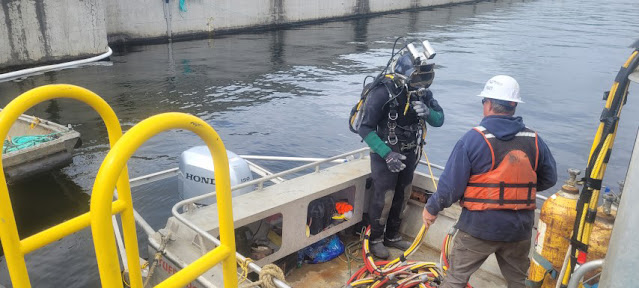What’s going on under the I-90 bridges across Lake Washington?
By Tony Black
If you’ve been driving over the I-90 floating bridges across Lake Washington these last couple months you’ve likely seen a big ‘ol crane sitting in the water. Well, technically it’s a crane sitting on a large barge, but it sounds more fascinating to keep it simple.
That crane is part of some interesting work to maintain the safety and integrity of the bridges. Between Mercer Island and Seattle, contractor crews are working on replacing more than 30 steel anchor cables which help keep the bridges stable and floating. But you may not see them doing the work. That’s because most of it happens underwater. So you’ll probably see the crane and barge (eyes on the road by the way!) but important work is happening below.
Why this work needs to be done
On average the work happens every 25 to 30 years as the cables endure years of pressure and stress from wind, waves, currents, and traffic loads. There are 108 cables total holding the bridges in place against those forces of wind and waves and over time, the cables corrode, rust and fray. The picture below is one of the first cables crews replaced when the project began in late April.
 |
| An old anchor cable pulled out from under Lake Washington. The cables that help hold the I-90 bridges up need to be replaced every 25-30 years. |
What they’re doing
So, what are they actually doing under there? Well, I know I’m not putting on scuba gear and diving into Lake Washington so the next best way to find out was from the project’s chief inspector.
 |
| The crane sitting on top of a large barge in Lake Washington is how crews tighten the new cables and remove the old ones. It takes about two days for each cable to be replaced. |
He told me the crane is used to help tighten the anchor cables as they’re installed. Each anchor cable takes about two days to remove and replace and once the process starts it is continuous until the new cable is re-tightened.
Lake Washington is no small lake – it’s more than 200 feet deep in some places and its sludge bottom is home to many items of history’s past including the old floating bridge which sank over Thanksgiving weekend in 1990. In fact, some of these anchor cables crews are working on are still connected to the old bridge.
That makes it pretty tough to see what’s going on down there (check out this video from a 2010 anchor cable replacement to get an idea.) Divers have a camera attached to their helmets so crews up top can use monitors as a guide and to see the divers’ movements. Divers are the critical element in replacing the cables as they locate the anchors on the bottom of the lake where the cables are attached, disconnect the old cables, and attach the new ones.
 |
| Divers have cameras on top of their gear to allow crews above water to monitor where the divers are going. They can talk with them in real-time to make sure everything goes smoothly. |
Once the divers have the cables in place, the crane gets to work. The cables can weigh several tons, so the cranes are used to help lift and position the cables so divers can work with them. Now while I haven’t jumped in Lake Washington, I have gone inside the pontoons that support the bridges and that’s the next critical step after the cables are in place.
 |
| Crews inside the floating pontoons under the I-90 bridges help secure the new cables to the pontoons to keep them firmly in place. |
Crews inside the pontoon position the cable for tightening along with the crane. This is how the cables stay in place once they’re set. The pontoons are watertight, and crews can safely complete their tasks without the need for oxygen tanks or scuba gear.
 |
| A closer look at how the anchor cables are secured to the pontoons |
Before we go…
A question we get a lot is about the divers and just how intense the work is they are doing. The answer is: It’s not easy by any means.
The work requires divers to work at depths of 180 feet for up to two hours at a time. Only one diver goes in with another on standby on the barge in case anything happens. Divers resurface in a cage which allows the dive team on board to carefully control their ascent.
 |
| A diver prepared to enter Lake Washington as part of the I-90 anchor cables replacement job. Divers go in one at a time and can be as deep as 180 feet for up to two hours. |
After resurfacing, the divers are taken to a decompression chamber as fast as possible. The diver is not in distress but using the decompression chamber is a standard part of the work to ensure the diver’s health and safety.
 |
| One of the new anchor cables preparing to be connected to pontoons under I-90 |
What’s next?
Since April, crews have replaced 18 steel cables – about half of the total they plan to do. Work should wrap up in September. These new cables will have a shelf life of 25 to 30 years, but remember there are 108 cables holding the bridges in place, so this won’t be the last time you see the crane and barge out on Lake Washington. At least now, you know what’s going on.
Post a Comment for "What’s going on under the I-90 bridges across Lake Washington?"